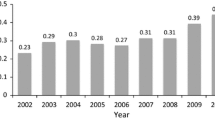Abstract
The purpose of our study was to describe the relationship between office-based provider visits and emergency department (ED) utilization by adult Medicaid beneficiaries. Data were extracted from the publicly-available Medical Expenditure Panel Survey, a nationally representative sample of the civilian non-institutionalized population in the United States. The sample included 1,497 respondents who had full year Medicaid coverage in 2009. Study variables included insurance coverage type, usual source of care, chronic illnesses, and beneficiary demographics. Multivariate analyses were conducted to describe associations between individual characteristics and (a) likelihood of any ED utilization, and (b) number of ED visits by those who utilized the ED at least once in the study year. The analysis was adjusted for demographic characteristics and chronic health conditions. A greater number of office-based provider visits was associated with a higher likelihood of ED utilization. Among those with at least one ED visit, a greater number of office-based visits was associated with a higher number of ED visits. A respondent’s age, history of hypertension or myocardial infarction, and Hispanic/Latino ethnicity were associated with having one or more ED visits; age and Hispanic/Latino ethnicity were associated with total number of ED visits among those with at least one. In this representative sample of adult Medicaid beneficiaries, there was no evidence that office-based provider visits reduced ED utilization. Office visits were associated with higher ED utilization, as were certain chronic conditions, older age, and Hispanic/Latino ethnicity. Findings do not support efforts to reduce ED utilization by increasing office-based visits alone.
Similar content being viewed by others
References
Tang, N., Stein, J., Hsia, R. Y., Maselli, J. H., & Gonzales, R. (2010). Trends and characteristics of US emergency department visits, 1997–2007. Journal of the American Medical Association, 304(6), 664–670.
Petersen, L. A., Burstin, H. R., O’Neil, A. C., Orav, E. J., & Brennan, T. A. (1998). Nonurgent emergency department visits: The effect of having a regular doctor. Medical Care, 36(8), 1249–1255.
Naderi, S., Barnett, B., Hoffman, R. S., et al. (2012). Factors associated with failure to follow-up at a medical clinic after an ED visit. The American Journal of Emergency Medicine, 30(2), 347–351.
Falik, M., Needleman, J., Wells, B. L., & Korb, J. (2001). Ambulatory care sensitive hospitalizations and emergency visits: Experience of Medicaid patients using federally qualified health centers. Medical Care, 39(6), 551–561.
McWilliams, A., Tapp, H., Barker, J., & Dublin, M. (2011). Cost analysis of the use of emergency departments for primary care services in Charlotte, North Carolina. North Carolina Medical Journal, 72(4), 265–271.
Kellerman, A. L., & Weinick, R. M. (2012). Emergency departments, Medicaid costs, and access to primary care—understanding the link. New England Journal of Medicine, 366(23), 2141–2143.
The Patient Protection and Affordable Care Act. Pub L No. 111–148. p. 124 Stat 119–124. http://www.gpo.gov/fdsys/pkg/PLAW-111publ148/html/PLAW-111publ148.htm. Accessed January 22, 2013.
Kaiser Family Foundation (2014). State decisions on health insurance marketplaces and the Medicaid expansion, 2014. http://kff.org/health-reform/state-indicator/state-decisions-for-creating-health-insurance-exchanges-and-expanding-medicaid. Accessed March 12, 2014.
Rosenblatt, R. A., Wright, G. E., Baldwin, L. M., et al. (2000). The effect of the doctor-patient relationship on emergency department use among the elderly. American Journal of Public Health, 90(1), 97–102.
Gill, J. M., Mainous, A. G, 3rd, & Nsereko, M. (2000). The effect of continuity of care on emergency department use. Archives of Family Medicine, 9(4), 333–338.
Cheung, P. T., Wiler, J. L., Lowe, R. A., & Ginde, A. A. (2012). National study of barriers to timely primary care and emergency department utilization among Medicaid beneficiaries. Annals of Emergency Medicine, 60(1), 4–10.
Duan, N., Manning, W. G. Jr., Morris, C. N., & Newhouse, J. P. (1983). A comparison of alternative models for the demand for medical care. Journal of Business & Economic Statistics, 1(2), 115–126 [Cited 2013 Jan 22]. http://www.rand.org/content/dam/rand/pubs/reports/2006/R2754.pdf
Hansagi, H., Olsson, M., Sjöberg, S., Tomson, Y., & Göransson, S. (2001). Frequent use of the hospital emergency department is indicative of high use of other health care services. Annals of Emergency Medicine, 37(6), 561–567.
Zuckerman, S., & Shen, Y. C. (2004). Characteristics of occasional and frequent emergency department users: Do insurance coverage and access to care matter? Medical Care, 42(2), 176–182.
O’Hara, B., Caswell, K. (2012). Health status, health insurance, and medical services utilization: 2010. Household Economic Studies Current Population Reports. Census Bureau, pp. 70–133.
Taubman, S. L., Allen, H. L., Wright, B. J., Baicker, K., & Finkelstein, A. N. (2014). Medicaid increases emergency department use: Evidence from Oregon’s health insurance experiment. Science, 343(6168), 263–268.
Herndon, J. B., Chaney, M., & Carden, D. (2011). Health literacy and emergency department outcomes: A systematic review. Annals of Emergency Medicine, 57(4), 334–345.
Billings, J., Parikh, N., & Mijanovich, T. (2000). Emergency department use: The New York story (pp. 1–12). Issue Brief (Commonwealth Fund), 434.
Roetzheim, R. G., Pal, N., Tennant, C., et al. (1999). Effects of health insurance and race on early detection of cancer. Journal of the National Cancer Institute, 91(16), 1409–1415.
Ayanian, J. Z., Kohler, B. A., Abe, T., & Epstein, A. M. (1993). The relation between health insurance coverage and clinical outcomes among women with breast cancer. New England Journal of Medicine, 329(5), 326–331.
Kelz, R. R., Gimotty, P. A., Polsky, D., Norman, S., Fraker, D., & DeMichele, A. (2004). Morbidity and mortality of colorectal carcinoma surgery differs by insurance status. Cancer, 101(10), 2187–2194.
Conflict of interest
The authors have no conflicts of interest to disclose.
Author information
Authors and Affiliations
Corresponding author
Rights and permissions
About this article
Cite this article
Widmer, A.J., Basu, R. & Hochhalter, A.K. The Association Between Office-Based Provider Visits and Emergency Department Utilization Among Medicaid Beneficiaries. J Community Health 40, 549–554 (2015). https://doi.org/10.1007/s10900-014-9970-3
Published:
Issue Date:
DOI: https://doi.org/10.1007/s10900-014-9970-3




